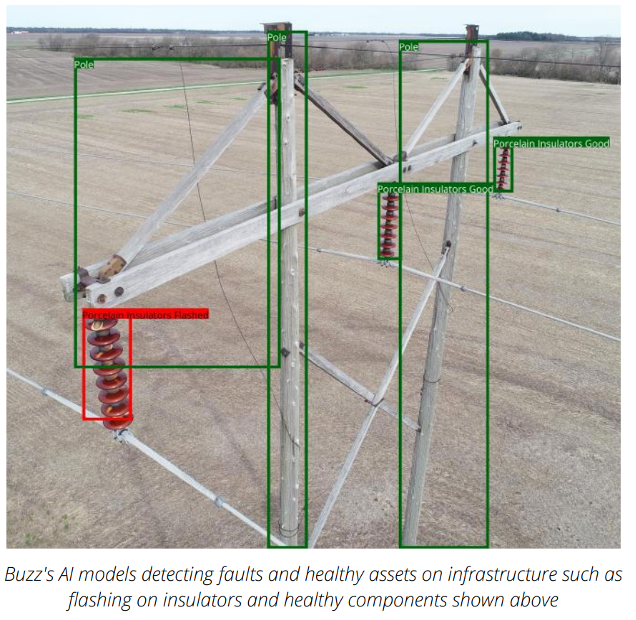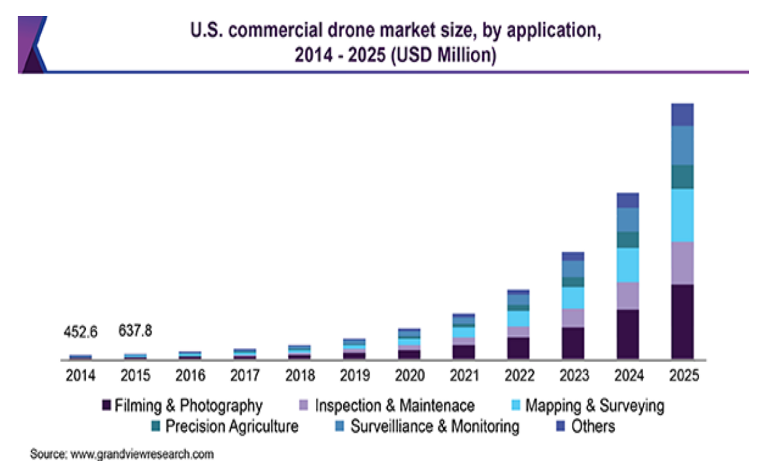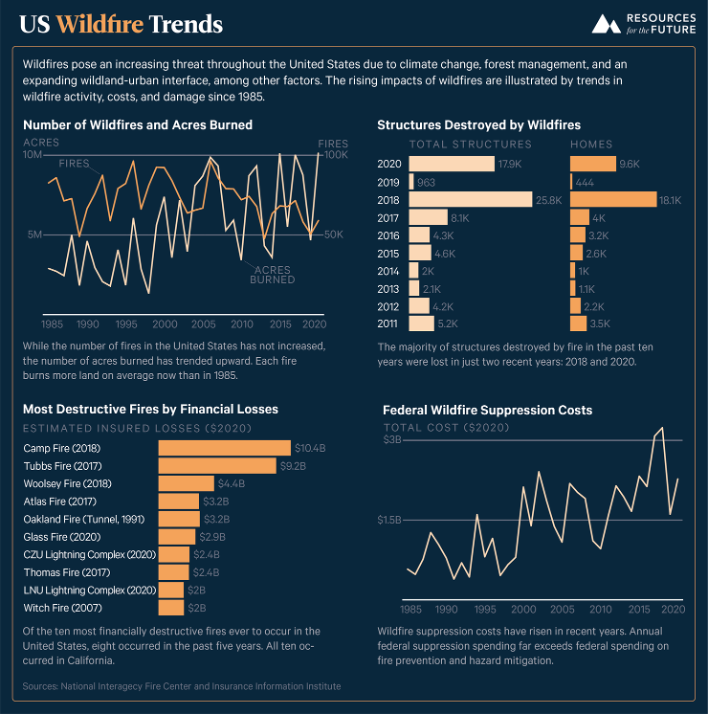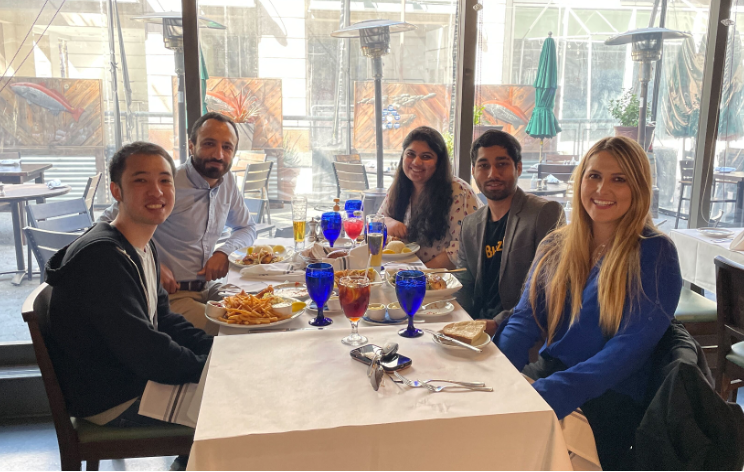Founder Profile: Kaitlyn Albertoli, CEO & Co-founder, Buzz Solutions
As the CEO and co-founder of Buzz Solutions, Kaitlyn Albertoli aspires to safeguard the world’s energy infrastructure. Throughout her career, she has been driven to solve big, challenging problems, and to have a substantial positive impact. Today, she and her team at Buzz have created an AI-powered platform that provides data management and analytics for grid inspections. We caught up with Kaitlyn to learn about her work at Buzz, their differentiated ‘AI-first approach’, and the impact of the bipartisan infrastructure bill on their path forward.

Source: Buzz White Paper
What life experiences brought you here? When did you decide you wanted to be an entrepreneur?
I’ve always been really entrepreneurially-focused. I actually had a jewelry business in high school that was all locally-sourced materials, and it started as a passion project. Then I became really interested in the whole business side of things–the pricing model, the go-to-market strategy, how you can more accurately build margins. That was my first interest on the entrepreneurial side, but later, I became involved in the world of sustainability.
After the jewelry business, I ran a sustainable food non-profit and it sparked an interest in doing something more impactful. That’s what ultimately led me to take the LaunchPad course at Stanford which was focused on entrepreneurship in the world of sustainability and energy. At Stanford I met my co-founder, Vik (n.b. prior to launching Buzz, Vik led machine learning and AI teams at Cisco Systems).We shared mutual interests in the energy space and sustainability, but with very different backgrounds, which were pretty complementary. And so it seemed like we had the makings of a really good team there and that’s ultimately where Buzz started.

Kaitlyn and Vik, on a job site together. Image courtesy of Buzz Solutions
Can you describe the problem you’re solving?
In order to talk about the problem we’re solving, it’s important to talk about the problem that was presented to us at the beginning. In 2017, the drone market was really starting to take off and mandates for more frequent powerline inspections were becoming the norm. This was before a lot of the wildfires that put climate change in the national and international spotlight and inspections of utility lines front and center. At that time, drone data collection use cases started to rise as utilities began collecting and analyzing millions of images.

Our focus was on the millions of annual images related to our transmission distribution infrastructure. In the current state, our entire process of managing that data, sharing it across teams, and then analyzing that data is still entirely manual. For example, one customer had 200 engineers, spending eight to nine hours a day just analyzing data all day, every day. That’s all they did– just to reduce the lag time from the moment that the image was captured to the time that it was processed. And when there’s that lag time, the data that’s being analyzed may no longer be accurate. In the 2018 timeframe, a major West Coast utility had 3700 unanswered maintenance requests. They were really having a hard time analyzing the data and then prioritizing their path to maintenance.

So that’s how it became very clear that we needed something to help streamline that process. As grid infrastructure continues to age and as we’re trying to onboard all these renewables onto the grid, having a robust grid is so incredibly important, and it’s often overlooked. That’s where we really see ourselves plugging in and bringing the most value.
For people that are less familiar with the process of a customer rollout in this specific realm, what are the steps required to provide actual data to the utility?
It’s a little bit different depending on which utility. There’s not yet a standard process, but right now utilities are contracting helicopter service providers, drone service providers, fixed wing aircrafts, sensor data, ground based imagery, or they’re doing one or many of those pieces in-house. So it’s about a 50/50 split between utilities that contract out to service providers or you know, the teams that are doing this type of data collection in house. And so depending on who the utility is, they could be collecting just general RGB imagery or they’re also collecting LIDAR data or thermal data. There’s a lot of new sensors that are coming into the fold. Now, they’re typically mandated to inspect a certain portion of their lines every year. And then on top of that, they’ll do on demand inspections for hotspot areas, or areas that are known to have higher risk where there may have been a storm or they know there could be some sort of failure to their infrastructure. They collect all that data and store it in the cloud.
Buzz provides an AI-powered Software Platform and Predictive Analytics for detecting faults and anomalies on power line assets. How should energy customers be thinking about the costs associated with fault detection?
It’s a good question. It’s a bit tough to quantify it now because there’s such a huge increase in the amount of data that’s being collected. I mean, these are unprecedented numbers of images and sensor data that’s being collected today. There’s also this compounding challenge of a big shortage of labor in this space right now. We have seen that our services save a minimum of 50% of direct costs compared to manual analysis. But that doesn’t take into account that there is also this huge shortage of labor and a massive surplus of data being collected.
What excites you most about your progress or traction to date?
The market is growing and expanding so quickly. We want to be on the cutting edge of analytics, AI and take the industry from being reactive to more predictive in its approach. (See: Buzz’s EPRI Incubatenergy Labs Case Study).

The Buzz team meets up in-person for the first time since the start of COVID
What is unique about your approach to machine vision and machine learning that your competitors haven’t yet figured out how to do?
We’re an AI first approach. We spent two years building out our commercially viable algorithms based on proprietary data sets we collected over that period of time. It’s very different from how a lot of the other competitors approached the market.
The bipartisan infrastructure bill is rolling out. How are you thinking about taking advantage of the federal dollars?Does that inform your work at all?
There’s so much information that’s constantly evolving and changing and moving quickly. But we’re fortunate to have partners who are long standing players in this space. For example, Power Engineers are always looking for new R&D opportunities, looking for ways to capitalize on some of the dollars that are coming through. We’re collaborating with them on how we can capitalize on some of those opportunities.
What is your grand vision if everything goes right?
Our goal is to safeguard the world’s energy infrastructure, not just power energy infrastructure. So we see our technology being applicable far beyond just the transmission and distribution inspection markets. We’ve already had new use cases with substations. We want to be that central brain for analyzing and then creating actionable insights from all of this data that’s being collected across various areas of infrastructure inspections, and so we’re really excited about how much growth there is across various areas of energy infrastructure.
––––––––––––––––––––––––––––––––––––––––––––––––––––––––––––––––––––––––––––
Were there ever points on that journey where you start to deviate from embracing risk or all the uncertainty that comes with entrepreneurship?
Yeah, I actually was studying mostly finance at school. Stanford doesn’t have a finance degree for undergrad but I was doing a make your own major that was something economics finance related. I did an internship in finance at JPMorgan and had planned to return there full time after I graduated. But something was just calling me back to the world of entrepreneurship and to the work that we had started at Buzz. Even though I really did enjoy the time that I was in banking, I wanted to be involved in an impact-focused company where I could be boots-on-the-ground in a startup. And so I feel like that’s where my passion is really aligned.
And are there any ways in which that major informs how you’ve approached your work at buzz or approaches your leadership style?
Absolutely. I mean, I think that it’s really great to have a team or we all come from such diverse backgrounds because we’re all able to bring such unique perspectives to the table at our collaborative discussions. That’s been really instrumental for us as we’re looking to build in our current market or as we are trying to be continually flexible and moving reflect the customer’s needs are I think it’s been helpful that we all do have such different backgrounds because we’re each able to bring a different a different hat to the table. Which has been really valuable for us in our small, like company team dynamic.
Have you ever thought about how if you weren’t building what you would be doing, and if money and procedure were no object— what is Kaitlyn’s dream alternate path?
I have always just followed, you know, what I’ve been passionate about, which is really solving what the biggest problems are that I’m uncovering. At any point in time. I don’t know that it’s necessarily 100% energy focused, but I do think the impact is a key component of it, because I always want to wake up every day going into work, doing something that I know is going to have a positive impact. And I think that that’s just a mindset that I’d like to take wherever I go in my future endeavors, not necessarily in one particular industry, but that’s definitely a common thread.
Are there any risks or threats that are keeping you up at night?
Absolutely, Always. Always. We’re a startup with limited resources and so figuring out how to balance that at any given time is always our biggest challenge and, and how to continue to grow and evolve and scale our market that utilities are definitely a challenging one. We want to find ways to be innovative, streamline our resources, and be as efficient as possible.
And how are you currently measuring success? What are the metrics that you’re using?
Time savings, cost savings, and reduced risk to the utility as a part of their inspection process are some of the key ways which we measure our success. Ultimately, beyond delivering actionable insights, we aim to help track assets and enable utilities to predict areas most prone to faults and failures.
Are there technological hurdles that you still need to overcome that are tied to any of these risks?
Always. I mean, there’s always things that are coming up as we’re looking at new sensor data and new use cases. As we continue to build new offerings, there are always challenges and hurdles along the way.
Would you be able to share a bit more about your team and its culture?
Absolutely. Our team is incredibly collaborative. And everyone at any level is able to really bring such strong unique ideas and perspectives to the table. I mean, hiring a very diverse team and bringing that into a core part of our culture is incredibly important to us. I think all areas of diversity, you know, diverse backgrounds, diverse thoughts, diverse perspectives and also people that are coming from even different areas of their career path as well. We want everyone to feel included, like they can bring their own ideas and perspectives to the table, and that they can truly contribute to the team culture.We are very interested in having team members join us who want to chase after this vision and are passionate about really being a part of an impactful startup. And so everyone that joins our team, we also want them to share that value as well that impact is at the core of what we’re doing here.